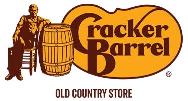Cracker Barrel Reports Second Quarter Fiscal 2019 Results
Page 3
February 26, 2019
About Cracker Barrel Old Country Store®
Cracker Barrel Old Country Store, Inc. (Nasdaq: CBRL) shares warm welcomes and friendly service while offering guests high-quality homestyle food and unique shopping – all at a fair price. By creating a world filled with hospitality and charm through an experience that combines dining and shopping, guests are cared for like family. Established in 1969 in Lebanon, Tenn., Cracker Barrel and its affiliates operate 659 company-owned Cracker Barrel Old Country Store® locations in 45 states and own the fast-casual Holler and Dash® restaurants. For more information about the company, visit crackerbarrel.com.
CBRL-F
Except for specific historical information, certain of the matters discussed in this press release may express or imply projections of revenues or expenditures, statements of plans and objectives or future operations or statements of future economic performance. These, and similar statements are forward-looking statements concerning matters that involve risks, uncertainties and other factors which may cause the actual performance of Cracker Barrel Old Country Store, Inc. and its subsidiaries to differ materially from those expressed or implied by this discussion. All forward-looking information is subject to completion of our financial procedures for Q2 FY 2019 and is provided pursuant to the safe harbor established under the Private Securities Litigation Reform Act of 1995 and should be evaluated in the context of these factors. Forward-looking statements generally can be identified by the use of forward-looking terminology such as “trends,” “assumptions,” “target,” “guidance,” “outlook,” “opportunity,” “future,” “plans,” “goals,” “objectives,” “expectations,” “near-term,” “long-term,” “projection,” “may,” “will,” “would,” “could,” “expect,” “intend,” “estimate,” “anticipate,” “believe,” “potential,” “regular,” “should,” “projects,” “forecasts,” or “continue” (or the negative or other derivatives of each of these terms) or similar terminology and include the expected effects of operational improvement initiatives, such as new menu items and retail offerings. Factors which could materially affect actual results include, but are not limited to: the effects of uncertain consumer confidence, higher costs for energy, general or regional economic weakness, and weather on sales and customer travel, discretionary income or personal expenditure activity of our customers; information technology-related incidents, including data privacy and information security breaches, whether as a result of infrastructure failures, employee or vendor errors, or actions of third parties; our ability to identify, acquire and sell successful new lines of retail merchandise and new menu items at our restaurants; our ability to sustain or the effects of plans intended to improve operational or marketing execution and performance; changes in or implementation of additional governmental or regulatory rules, regulations and interpretations affecting tax, wage and hour matters, health and safety, pensions, insurance or other undeterminable areas; the effects of plans intended to promote or protect our brands and products; commodity price increases; the ability of and cost to us to recruit, train, and retain qualified hourly and management employees in an escalating wage environment; the effects of increased competition at our locations on sales and on labor recruiting, cost, and retention; workers’ compensation, group health and utility price changes; consumer behavior based on negative publicity or concerns over nutritional or safety aspects of our food or products or those of the restaurant industry in general, including concerns about pandemics, as well as the possible effects of such events on the price or availability of ingredients used in our restaurants; the effects of our indebtedness and associated restrictions on our financial and operating
- MORE -

